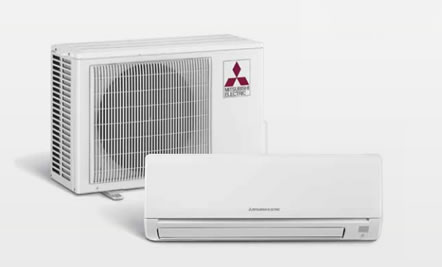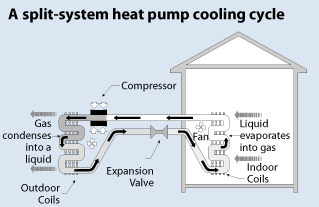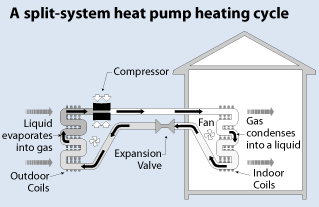“Heat pumps” are well known to HVAC professionals and energy-efficiency experts. Heat-pump based systems have been used for years in milder climates to warm and cool homes and other buildings. In the past few years, the technology has improved to the point that heat pumps are now becoming popular in colder climates like New England.
What is a heat pump?
It’s a bunch of equipment that collects heat from the air, water or ground, and transfers it to another space, or a body of water. They’re ultra energy efficient because they move heat instead of creating it like your oil-burning furnace does (or most other traditional heating systems).
The term “heat pump” is confusing because it suggests that the devices are only for heating. Actually, they move heat in whatever direction is desired. Heat pumps move heat out of a warm space (air conditioning) or into a cold space (heating.) That’s the magical thing about heat pumps.
You already have a heat pump in your home. It’s your refrigerator. Your fridge stays cool by pulling warm air out of the fridge and moving it into your kitchen. That’s why parts of your fridge are warm to the touch or you feel a warm breeze on your bare feet when you walk by on a cool morning.
Cool. What else can heat pumps do for me?
Heat pumps in the home include:
- Air-to-air: A ductless mini-split transfers heat between the outside and inside of your home. Ducted air-source heat pumps are also available.
- Ground-to-air: A geothermal system transfers heat to or from the ground water near your home to or from the air in your home.
- Air-to-water: A heat pump water heater draws heat from your home to heat the water in your water tank.
Tell me more about mini-splits.
Traditionally, heat pumps run on electricity. The electricity powers a compressor and fluid/gas circulator pump. That means they work great with a New England Clean Energy solar energy system. If you combine a mini-split with a solar electric system, you can use your solar to heat and cool your home, and have truly emissions-free, guilt-free A/C and shoulder season heat. Because they’re ductless, they’re easy and quick to install, and don’t require tearing up your walls or ceilings.
Mini-splits are often smaller than typical heat pumps, hence the “mini” in the name. And like many HVAC systems, they are “split” – in this case, into an outdoor and indoor unit(s).
How does a heat pump actually work?
Hot or cold air doesn’t actually move through a heat pump. That’s where phase change comes in. Phase change is a process where a substance changes from solid, liquid or gas, to another form. For example, water transitions from liquid to gas by evaporation or from gas to liquid by condensation. Here’s a fun one: did you know mothballs (1,4-dichlorobenzene) transition from solid to gas under normal atmospheric conditions (called sublimation)?
As it turns out, when a gas condenses (or is condensed) to a liquid, the condensing substance cools down. Put another way, the process gives off heat. When liquid evaporates (or is evaporated) to a gas, the evaporating substance heats up – the process draws in heat.
I said above that electricity powers a compressor in a heat pump. The compressor causes the gas in the heat pump to undergo a phase change to liquid, or an evaporator causes the liquid to change to gas, creating the desired cooling or heating effect.
These diagrams from energy.gov illustrate how a heat pump works. Notice how the same system works for heating or cooling; only the direction of the arrows changes.
You’ve whetted my appetite. Where can I learn more?
The Internet has plenty of resources on heat pumps, including energy.gov and this article.
If you liked this article, you might also enjoy:








6 Responses to “The Magic of Heat Pumps”
Great article!
Write more about the heating side of mini-splits, namely:
-shoulder seasons — what outside temps work best for HPs?
-what is the efficiency of a heat pump compared to a high efficiency gas boiler?
Hi Steve – Both great ideas. Look for future blog posts about how mini-splits work in New England, and the efficiency of heat pumps vs. other heating sources. — Mark
Hi Steve – Just letting you know Mark has posted a new piece, on heat pump efficiency compared to gas and other New England heating systems.
Finally I found out, A “ductless mini-split” is a small heat pump. Pardon me, I can’t find out much technical information on them. I would like to download an install/service manual. Specifically the electrical schematic end. I would like to know the power draw. Is the compressor motor control a VFD (variable frequency drive)? or are they a PSC (permanent split capacitor motor) or the old tech thermal relay start winding. How much power draw in KVA? Before I would introduce this new technology to my home I want to qualify it to see if I can run it on a backup generator.
I selected my refrigerator, washer, gas stove, replacement oil burner gun and I found out there is a huge difference in what is available out there. During our last outage I was able to run the entire house on an 800 Watt 2 cycle “chainsaw engine” generator. I had to forego the toaster, electric perk, but that is what the gas stove is for. Some forethought on selection can turn a hardship situation into a minor annoyance. If I had a Tesla Power wall maybe I would have never noticed.
Edward – Thanks for your comment. The power draw of these units depends on many variables, including: the unit’s rated capacity, outside temperature, temperature set point, whether you are heating or cooling, etc. Here’s one example: a 24,000 BTU/hr (2 ton) rated “hyper heat” system in heating mode will use 1,622 watts heating at its rated capacity, at 17 deg F outside temperature. These units use DC inverter-driven twin rotary compressors, which actively throttle motor speed to match demand, so the actual power draw will vary depending on performance requirements. The max draw of the units also vary, as you may expect. The compressor for the 24,000 BTU/hr unit in the above example has an RLA of 20 amps, so it will draw a maximum of 4800 watts during operation (though it will generally be much less than this).
Regarding running these units from a generator, I don’t suspect there will be an issue if using an appropriately sized inverter generator, however, we do not have any specific knowledge on the topic, so we cannot necessarily condone it.
If you are interested in learning more about the technical specs on specific mini-split units, please visit this page on Mitsubishi’s website:
http://www.mitsubishipro.com/en/professional/products/heat-pump-systems#5313
The comments are closed.